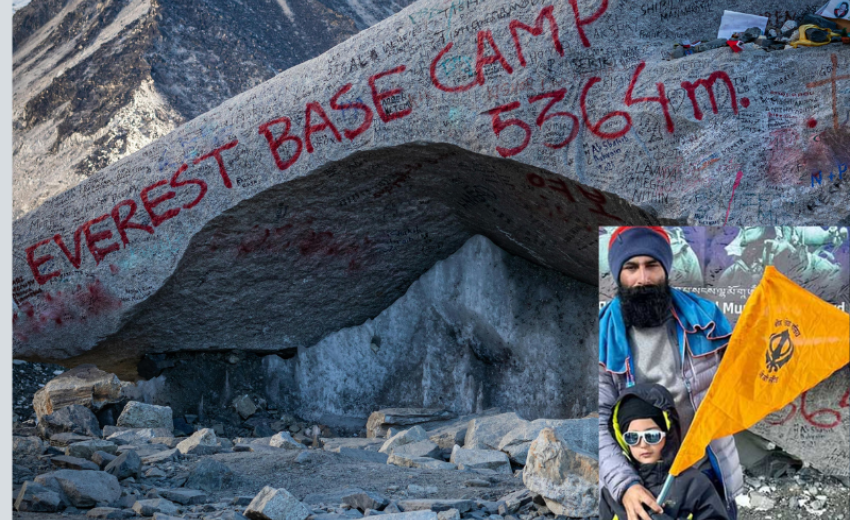10-Day Trek Sets New Record for Youngest Sikh to Achieve Ascent at Everest Base Camp
Tegbir Singh, age five and a 1st Standard student in Shiwalik Public School of Ropar a state of eastern Punjab in Northwest India, set a new record in April 2024 as the youngest Sikh ever to reach a Mount Everest Base Camp. Hiking with his father Tegbir Singh’s record-setting trek took 10 days of rigorous hiking and required a year of training to prepare for the challenges of sustained hiking in a high-altitude climate.
Training, and Preparation
Inspired by record record-setting Sikh mountaineers and other young climbers, Tegbir Singh, the son of hospital administrator Sukhinderdeep Singh and his wife Dr Manpreet Kaur, began preparation for his climb at age four with Bikramjit Singh Ghuman, a retired coach. Bikram Singh designed a strict diet regimen and trained Tegbir Singh with cardio exercises designed to increase lung capacity. Training to build stamina for the rigors of high-altitude climbing included weekly hikes in various mountainous areas accompanied by his father and his coach.
Trek to South Base Camp Nepal
Tegbir Singh flew with his father on April 8, 2024, from Kathmandu to Lukla, which has an elevation of 9,3334 ft (2,845 m) and has been rated as the most dangerous airport in the world. They began their trek the next day, on the 9th of April, all the while climbing steadily at an ever-increasing altitude with an ever-decreasing oxygen level in temperatures well below freezing. Tegbir Singh hiked the entire 33-mile (53 km) trek, turning down well-meaning offers of mule rides, insisting that he wanted to reach the base camp with his own two feet. Supported by the principles of his Sikh faith, five-year-old Tebir Singh listened to stories of Sikh heroes told by his father and recited “Waheguru Waheguru” along the way to maintain the keep-up spirit of Chardhi Kalaa whenever he felt tired. Hiking five to six miles (8 to 10 km) each day, they reached their destination on the 17th of April arriving at South Base Camp of Mount Everest in Nepal, which has an altitude of 17,598 ft (5,364m) and a temperature of 10.4 degrees Fahrenheit (- 12 Celsius). Tegbir Singh marked his ascent with an orange-colored flag on which is printed a blue khanda, a symbol of the Sikh faith, and had a photograph taken with his father at the Base Camp summit to record his achievement. Inspired by his success, Tegbir Singh, the youngest Sikh Mountaineer, is already dreaming of new and higher summits to be conquered in the years to come and hopes one day to successfully scale Mount Everest.
Base Camp Trekking Packages and Independent Hikes
If you are feeling fit and inspired to trace little Tegbir Singh’s footprints, here are a few things you need to know. There are no roads to Lukla. Before 1964 the only way to reach Lukla would have been a road trip of 1 or 2 days by jeep followed by 2 or 3 days on foot, and doing that is still an option. Since the building of the airport in Lukla in 1964, trekking to Base Camp has become popular as a tourist destination. About 40,000 people make the trek to South Base Camp in Nepal each year. Round-trip, 12-day, tour packages from Kathmandu begin at about $1500 (USD) for a single person, $1300 each for two, and $1200 each for four, and include flights, permits, a guide, porters, accommodations, and food. You will need a sleeping bag and personal gear. It is also possible to pay for flights independently, buy permits, hire your own required guide and porter, choose an accommodation, and pay for hot showers, Wi-Fi, charging, and food separately. Costs add up and you could easily spend more, but you also have more flexibility. Be sure to carry cash in the local currency whichever option you choose, $5 (USD) is equal to about 66,799.00 Nepalese Rupees (NRP)
Beyond Base Camp
Should you wish to continue trekking up the Nepal or South route to Mount Everest, there are four more camps beyond base camp before reaching the summit. Each camp provides periods of rest and acclimatization which require trips back and forth between successive camps. Returning to the lower camp and reascending the following day in graduated steps, altogether takes from 8 – 16 days of trekking, depending on the weather. The so-called “death zone” is the final stage between the 4th camp and the summit where most climbers succumb due to edema or swelling in the lungs and brain. It is highly advisable to use oxygen, before reaching the summit and while beginning the return trip, which is done the same day:
- Base Camp is 17,598 ft or 5,364 m
- Camp 1 or Resting Camp is 18,489 ft or 6,065 m
- Camp 2 or Advanced Base Camp is 21,000, ft or 6,400 m
- Camp 3 or Acclimatization Camp is 23,500 ft or 6,800m
- Camp 4 or Death Zone is 26,000ft or 8,000 m
- Summit is 29, 029 ft or 8,848 m
Feats of Record-Setting Sikh Mountaineers Who Inspired Tegbir Singh
Interest in scaling Mount Everest began in the 1920s, but not until the 1950s when proclaimed the tallest mountain in the world did expeditions to scale Everest begin in earnest with regularity. Sir Edmund Hillary became the first to reach the summit on May 29, 1953. His success spurned several attempts by various Indian expeditions and courageous mountaineers who helped to inspire the youngest record-setting Sikh mountaineer five-year-old Tegbir Singh.
- Brigadier Gyan Singh led the first attempt by the Indian Army expedition in 1960 but failed to reach the summit.
- Manmohan Singh Kholi led several expeditions attempting to scale Everest or nearby peaks:
- In 1962, during the first attempt the expedition spent three nights on the mountain below the summit. They went two nights without oxygen, trapped by blizzard conditions, which forced their return before completing the ascent, just 400 ft or 122 m, feet below the summit.
- In 1964, Kohli attempted the ascent of a lesser peak, Nanda Devi East, where two avalanches and steep falls of over 3,000 ft or 1,000 m by two climbers prevented his expedition from reaching the summit.
- Then in 1965, Kholi again attempted the summit of Mount Everest when leading the Indian Mountaineering Foundation expedition. The team made four attempts between late April and late May and 9 climbers succeeded in successfully reaching the summit. These included several Sikhs:
- Lt Col Avatar Singh Cheema on May 20, 1965, became the first Indian, and 16th person, to scale Everest.
- Major Hari Pal Singh became the 6th Indian and 21st person along with Harish Chandra Singh 7th Indian and 22nd to successfully scale Mount Everest on May 29, 1965.
- Team member Major BP Singh had also been selected to surmount the peak but had to turn back because of physical impairment. Gurdial Singh another team member became a lifelong mountaineer.
- Brigadier Saurabh Singh Shekhawat (KC, SC, SM, VSM, 21 Para SF), an avid mountaineer, ascended to conquer the summit of Mount Everest three separate times in 2001, 2003, and 2005.
- Colonel Ranveer Singh Jamwal (SM VSM) scaled the Seven Summits: Aconcagua of Argentina, Denali of Alaska, Mount Elbrus of Russia, Kilimanjaro of Tanzania, Puncak Jaya of Oceana, Vision Massif of Antarctica. He also ascended the summit of Mount Everest in Nepal, three separate times, twice within one year on May 25, 2012, and again 360 days later on May 19, 2013.
- A team of six teens, including two Sikhs, underwent seven months of training to conquer the summit of Mount Everest on May 21, 2013:
- Major Fateh Singh Brar ascended the summit of Mount Everest at the age of 16 years and 9 months.
- Guribadat Singh age 17, refused to cut his hair after being advised by a sherpa that heavy snow could hinder him and cause paralysis. Guribadat Singh had a first-hand encounter with the risks he had faced when noticing a blue object in the snow. He reached out to touch it and then realized it to be the body of a climber who had perished without ever having been retrieved from the mountain and lay where he had taken his final breath.
- Baljeet Kaur of Himachal Pradesh became the first Sikh woman to reach the summit of Mount Everest:
- In 2016, she had to abandon her attempt to reach the summit when her Oxygen mask malfunctioned.
- In 2022, at age 26 she scaled five separate peaks over 26,250 ft or 8,000 m, in under a month from late April through late May:
- Annapurna on April 18, where she had to be rescued after being abandoned by a sherpa when she began experiencing hallucinations due to high altitude and low oxygen.
- Kanchenjunga on May 12.
- Everest on May 22.
- Lhotse on May 23.
- Makalu on May 28.
Having nearly lost her life to altitude sickness from being low on oxygen, Baljeet Kaur has offered adamant advice that everyone should heed when it comes to trekking. Take no shortcuts of any kind. Before setting out, one must be fit, have funding, and choose a reputable agency to provide a trustworthy sherpa.






